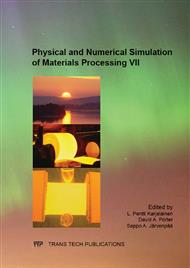[1]
D. Cornette, P. Cugy, A. Hildenbrand, M. Bouzekri and G. Lovato: Revue Métall. Vol. 102 (2005), p.905
DOI: 10.1051/metal:2005151
Google Scholar
[2]
C. Scott, S. Allain, M. Faral and N. Guelton: Revue Métall. Vol. 103 (2006), p.293
Google Scholar
[3]
A. S. Hamada, Manufacturing, mechanical properties and corrosion behavior of high-Mn TWIP steels, PhD Thesis, University of Oulu, Acta Univ. Oul. C 281, (2007)
Google Scholar
[4]
A. Saeed-Akbari, L. Mosecker, A. Schwedt and W. Bleck: Metall. Mater. Trans. A Vol. 43A (2012), p.1688
Google Scholar
[5]
L. Chen, Han-soo Kim, Sung-Kyu Kim and B.C. De-Cooman: ISIJ Int. Vol. 47 (2007), p.1804
Google Scholar
[6]
O. Bouaziz, S. Allain, C.P. Scott, P. Cugy and D. Barbier: Curr. Opin. Solid State Mater. Sci. Vol. 15 (2011) , p.141
Google Scholar
[7]
A.S. Hamada, L.P. Karjalainen and J. Puustinen: Mater. Sci. Eng. A Vol. 517 (2009), p.68
Google Scholar
[8]
A.S. Hamada and L.P. Karjalainen: Mater. Sci. Eng. A Vol. 527 (2010), p.5715
Google Scholar
[9]
L.P. Karjalainen, A. Hamada, R. D.K. Misra and D.A. Porter: Scripta Mater. Vol. 66 (2012), p.1034
Google Scholar
[10]
T. Niendorf, F. Rubitschek, H.J. Maier, J. Niendorf, H.A. Richard and A. Frehn: Mater. Sci. Eng. A Vol. 527 (2010), p.2412
DOI: 10.1016/j.msea.2009.12.012
Google Scholar
[11]
T. Niendorf, C. Lotze, D. Canadin, A. Frehn and H.J. Maier: Mater. Sci. Eng. A Vol. 499 (2009), p.518
Google Scholar
[12]
J. Man, T. Vystavel, A. Weidner, I. Kubena, M. Petrenec, T. Kruml and J. Polák: Int. J. Fatigue Vol. 39 (2012), p.44
Google Scholar
[13]
D. Barbier, N. Gey, S. Allain, N. Bozzolo and M. Humbert: Mater. Sci. Eng. A Vol. 500 (2009), p.196
Google Scholar
[14]
J. Man, K. Obrtlík and J. Polák: Phil. Mag. Vol. 89 (2009), p.1295
Google Scholar
[15]
Z.F. Zhang and Z.G. Wang: Prog. Mater. Sci. Vol. 53 (2008), p.1025
Google Scholar
[16]
Y. Nakai: Mater. Sci. Res. Int. Vol. 7 (2001), p.73
Google Scholar
[17]
S. Suresh, Fatigue of Materials, second ed., Cambridge University Press, UK, (2001)
Google Scholar
[18]
P. Zhang, Z.J. Zhang, L.L. Li and Z.F. Zhang: Scripta Mater. Vol. 66 (2012), p.854
Google Scholar
[19]
X.G. Wang, V. Crupi, X.L. Guo and Y.G. Zhao: Int. J. Fatigue Vol. 32 (2010), p. (1970)
Google Scholar
[20]
A. Dumay, J.-P. Chateau, S. Allain, S. Migot and O. Bouaziz: Mater. Sci. Eng. A Vo. 483–484 (2008), p.184
Google Scholar
[21]
S. Allain, J.-P. Chateau, O. Bouaziz, S. Migot and N. Guelton: Mater. Sci. Eng. Vol. A 387–389 (2004), p.158.
Google Scholar


